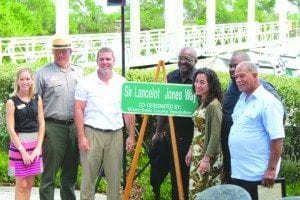
A revered pioneer gained recognition of his place in South Florida history before a sprinkling of 30 residents and area officials on Oct. 12, the Columbus Day holiday before Florida’s first “Lancelot Jones Day.”
Born on a sailboat on Biscayne Bay, Lancelot Jones was honored with the naming of SW 328th Street as “Lancelot Jones Way.” SW 328th Street is the seven-andone- half-mile entrance road to Biscayne National Park, largest marine park in a system that protects the longest stretch of mangrove forest on Florida’s East Coast.
The occasion also was the official announcement of the Second Monday of October in Miami-Dade and Monroe Counties as “Lancelot Jones Day,” attested by resolutions and twin plaques bearing signatures of Senate and House leaders and presented by Erin Muir, a legislative assistant to State Rep. Holly Raschein whose District 120 covers more than 50 of the northernmost Florida Keys, the northern end of the world’s thirdlongest reef tract.
“Without him, this park probably would not exist today,” declared Park Ranger Gary A. Bremer who joined National Parks Superintendent Brian Carlstrom and others in sharing recollections and memories of Jones during a dedication ceremony at the Dante Fascell Visitor Center pavilion adjoining its colorful marina filled with sail and power boats.
Of Bahamian heritage, Jones lived most of his life on Porgy Key in lower Biscayne Bay where he gathered and cultivated sponges and grew key limes and pineapples trees as one of Florida’s earliest bayside agriculturalists.
In 1970, Jones and a sister-in-law sold the 277 acres comprising Porgey, Trotten and Old Rhoads Keys to the federal government for $1.2 million along with an agreement that permited Jones to remain living in his two-story concrete home until his passing. The Jones family site is now listed on the National Registry of Historic Places.
“I think it’s good for people to have somewhere that they can go to leave the hustle and bustle behind, and get out in the quietude of nature,” Jones said at the time he sold his land.
“When I once asked Lancelot why he lived in isolation, he said he didn’t like hoop-la — perhaps just what we are doing today,” chuckled Bremer, holding a native Key sponge and recalling that Jones said he began selling sponges at age 10, “not as a living then but to buy peppermint stick candy he liked so well.”
In later years before his death in 1997 at age 99, Jones interacted with park visitors, teaching about the bay’s ecosystem, including schoolchildren visiting the nearby Adams Key Ranger Station’s Environmental Education Center.
“They say that Sir Lancelot was King Arthur’s favorite knight,” said Miami- Dade Commissioner Dennis Moss. “If so, then Sir Lancelot Jones is our community knight for his dedication in preserving this beautiful part of Biscayne Bay.”
Joining him in telling Lancelot Jones stories and expressing their thanks were State Sen. Dwight Bullard; Jacqueline Crucet of the National Parks Conservation Association; Homestead Vice Mayor Stephen Shelley, and Robert O’Bryant, director of the Mahogany Youth Corporation, a fishing educational program for schoolchildren.
A personal note: This writer recalls a Sunday in the 1980s when a friend of Jones took his family through a maze of Black Caesar Creek mangroves aboard a 32-foot sport fisherman, bringing mail and canned goods for a visit with Jones.
After a tour of his sponge-crowded and non-air-conditioned home on a 95-plus degree afternoon, Jones ferried his visitors aboard a john-boat to the larger craft, unable to anchor in the shallow waters of the settlement’s wooden dock.
Embarking with our farewell words:
“We hope we’ll be back to see you again,” Jones lifted a forehead beaded with perspiration beneath a weather-beaten fisherman’s hat to reply with a broad smile:
“I’ll be here when you come…and I’ll be here when you go.”






